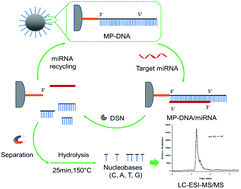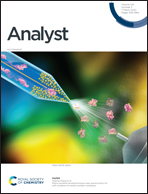Mass spectrometric quantification of microRNAs in biological samples based on multistage signal amplification†
Abstract
This work describes a novel method for quantification of miRNAs based on multistage signal amplification (MSA) and liquid chromatography-electrospray ionization tandem mass spectrometry (LC-ESI-MS/MS). The multistage signal amplification involves hybridization enrichment of miRNA targets with a DNA probe-magnetic bead conjugate, target recycling amplification with a duplex-specific nuclease, and acid hydrolysis of the reporter molecules producing free nucleobases. Nucleobases thus generated are quantified by LC-ESI-MS/MS with specificity and repeatability. Taking miR-21 as the model target, biological samples such as serum and cell cultures were analyzed by using the present protocol. The analytical results indicate that facile and cost-effective quantifications of miRNA targets can be achieved by using the popular LC-ESI-MS/MS technique, and very importantly, without an isolation of total RNAs from the sample prior to the quantitative assay. The assay for miR-21 detection had a linear calibration curve in the range from 0.2 pM to 0.25 nM with a limit of detection of 60 fM. Analysis of MCF-7 cells treated with toremifene (a potent inhibitor of breast cancer cell growth) revealed that the content of miRNA-21 decreased by ca. 50%, and the decrease was dose-dependent.



 Please wait while we load your content...
Please wait while we load your content...